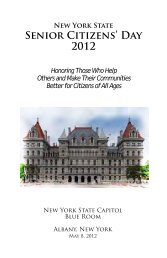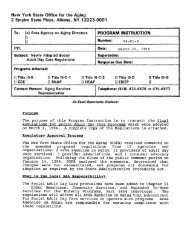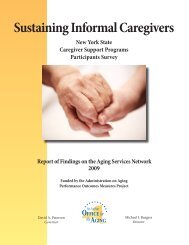White Paper - New York State Office for the Aging
White Paper - New York State Office for the Aging
White Paper - New York State Office for the Aging
- No tags were found...
Create successful ePaper yourself
Turn your PDF publications into a flip-book with our unique Google optimized e-Paper software.
ANALYSIS AND SUMMARY OF 36 STATE AGENCY BRIEFS<br />
funds county clerk operations. However, as retirees engage in certain second and third<br />
careers and occupations, revenues from professional license and registration fees may<br />
increase.<br />
• There may be increasing numbers of participants in <strong>the</strong> STAR (property tax) and<br />
SCRIE (rent subsidy) programs, but a declining number of veterans eligible <strong>for</strong> veterans’<br />
exemption programs.<br />
• Exemption, reduced-cost, and free programs that target a growing number of<br />
older people and persons with disabilities will strain program and community operating<br />
budgets. However, policy changes in <strong>the</strong>se types of programs may result in increased<br />
revenues.<br />
The work<strong>for</strong>ce: For several years, through <strong>the</strong> Department of Civil Service and<br />
<strong>the</strong> Governor's <strong>Office</strong> of Employee Relations, state agencies have been engaged in a<br />
government-wide work<strong>for</strong>ce succession planning initiative in response to <strong>the</strong> aging of <strong>the</strong><br />
<strong>State</strong>'s public sector work<strong>for</strong>ce and <strong>the</strong> rapidly changing nature of <strong>the</strong> <strong>New</strong> <strong>York</strong>'s labor<br />
pool. In <strong>the</strong>ir deliberations <strong>for</strong> <strong>the</strong> Project 2015 initiative, agencies described <strong>the</strong> impact<br />
of <strong>the</strong> aging of <strong>the</strong>ir own staffs and <strong>the</strong> staffs of <strong>the</strong>ir statewide networks of voluntary<br />
providers, <strong>the</strong> impact of impending general mass retirements, and <strong>the</strong> implications of<br />
mass retirements expected among specific occupations, such as <strong>the</strong> state police, fire<br />
department personnel, teachers, and state agency management-level personnel. Some<br />
examples include:<br />
• The impending loss of a large number of qualified workers through retirement<br />
will result in less stability and increased turnover in <strong>the</strong> state work<strong>for</strong>ce. The magnitude<br />
of <strong>the</strong> impending retirements will result in <strong>the</strong> <strong>State</strong> losing <strong>the</strong> institutional memory, high<br />
level skills, experience, fundamental program knowledge, mentoring capacity, and talents<br />
gained by workers over <strong>the</strong> course of 20- and 30-year careers.<br />
• Both <strong>the</strong> increasing numbers of public sector retirees and <strong>the</strong>ir longer retirement<br />
periods will dramatically increase <strong>the</strong> <strong>State</strong>'s benefits costs (pensions and health care),<br />
resulting in hard choices about resource allocation. Agencies questioned whe<strong>the</strong>r new,<br />
creative fringe benefit products and new, flexible work options need to be developed to<br />
constrain costs and to respond to <strong>the</strong> changing preferences of <strong>the</strong> public work<strong>for</strong>ce.<br />
• For many agencies, over half <strong>the</strong>ir staffs are over <strong>the</strong> age of 50. There will be a<br />
growing demand <strong>for</strong> changes to create work-site environments that respond to <strong>the</strong> needs<br />
of older and disabled workers, including physical modifications, assistive devices,<br />
flexible work schedules and work arrangements, greater use of family leave <strong>for</strong><br />
caregiving responsibilities, educational programs on aging and caregiving issues, and<br />
sensitivity training <strong>for</strong> managers regarding <strong>the</strong> traits and needs of older workers.<br />
• Greater flexibility is needed in hiring and retention policies. Current civil service<br />
practices must be reconsidered, and new, creative strategies are needed to recruit<br />
younger-aged workers; recruit from nontraditional applicant pools, such as immigrant<br />
27








